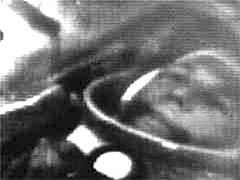Vostok 1

Yuri Gagarin aboard Vostok 1, as televised to launch control
|
|||||
| Operator | Soviet space program | ||||
|---|---|---|---|---|---|
| Harvard designation | 1961 Mu 1 | ||||
| SATCAT № | 103 | ||||
| Mission duration | 1 hour, 48 minutes | ||||
| Orbits completed | 1 | ||||
| Spacecraft properties | |||||
| Spacecraft | Vostok-3KA No.3 | ||||
| Manufacturer | Experimental Design Bureau OKB-1 | ||||
| Launch mass | 4,725 kilograms (10,417 lb) | ||||
| Landing mass | 2,400 kilograms (5,290 lb) | ||||
| Dimensions | 2.30 meters (90.5 in) diameter | ||||
| Crew | |||||
| Crew size | 1 | ||||
| Members | Yuri Gagarin | ||||
| Callsign | Кедр (Kedr – Siberian Pine) | ||||
| Start of mission | |||||
| Launch date | April 12, 1961, 06:07 UTC | ||||
| Rocket | Vostok-K 8K72K | ||||
| Launch site |
Baikonur 1/5 45°55′13″N 63°20′32″E / 45.920278°N 63.342222°E |
||||
| End of mission | |||||
| Landing date | April 12, 1961, 07:55 UTC | ||||
| Landing site | 51°16′14″N 45°59′50″E / 51.270682°N 45.99727°E | ||||
| Orbital parameters | |||||
| Reference system | Geocentric | ||||
| Regime | Low Earth | ||||
| Perigee | 169 kilometers (91 nautical miles) | ||||
| Apogee | 327 kilometers (177 nautical miles) | ||||
| Inclination | 64.95 degrees | ||||
| Period | 89.1 minutes | ||||
| Epoch | 12 April 1961 | ||||
|
|||||
Vostok 1 (Russian: Восто́к-1, East 1 or Orient 1) was the first spaceflight of the Vostok programme and the first manned spaceflight in history. The Vostok 3KA space capsule was launched on April 12, 1961 from Baikonur Cosmodrome with Soviet cosmonaut Yuri Gagarin, making him the first human to cross into outer space.
The orbital spaceflight consisted of a single orbit around Earth which skimmed the upper atmosphere at 169 kilometers (91 nautical miles) at its lowest point. The flight took 108 minutes from launch to landing. Gagarin parachuted to the ground separately from his capsule after ejecting at 7 km (23,000 ft) altitude.
The Space Race between the Soviet Union and the United States, the two Cold War superpowers, began just before the Soviet Union launched the world's first artificial satellite, Sputnik 1, in 1957. Both countries wanted to develop spaceflight technology quickly, particularly by launching the first successful human spaceflight. The Soviet Union secretly pursued the Vostok programme in competition with the United States Project Mercury. Vostok launched several precursor unmanned missions between May 1960 and March 1961, to test and develop the Vostok rocket family and space capsule. These missions had varied degrees of success, but the final two—Korabl-Sputnik 4 and Korabl-Sputnik 5—were complete successes, allowing the first manned flight.
...
Wikipedia


